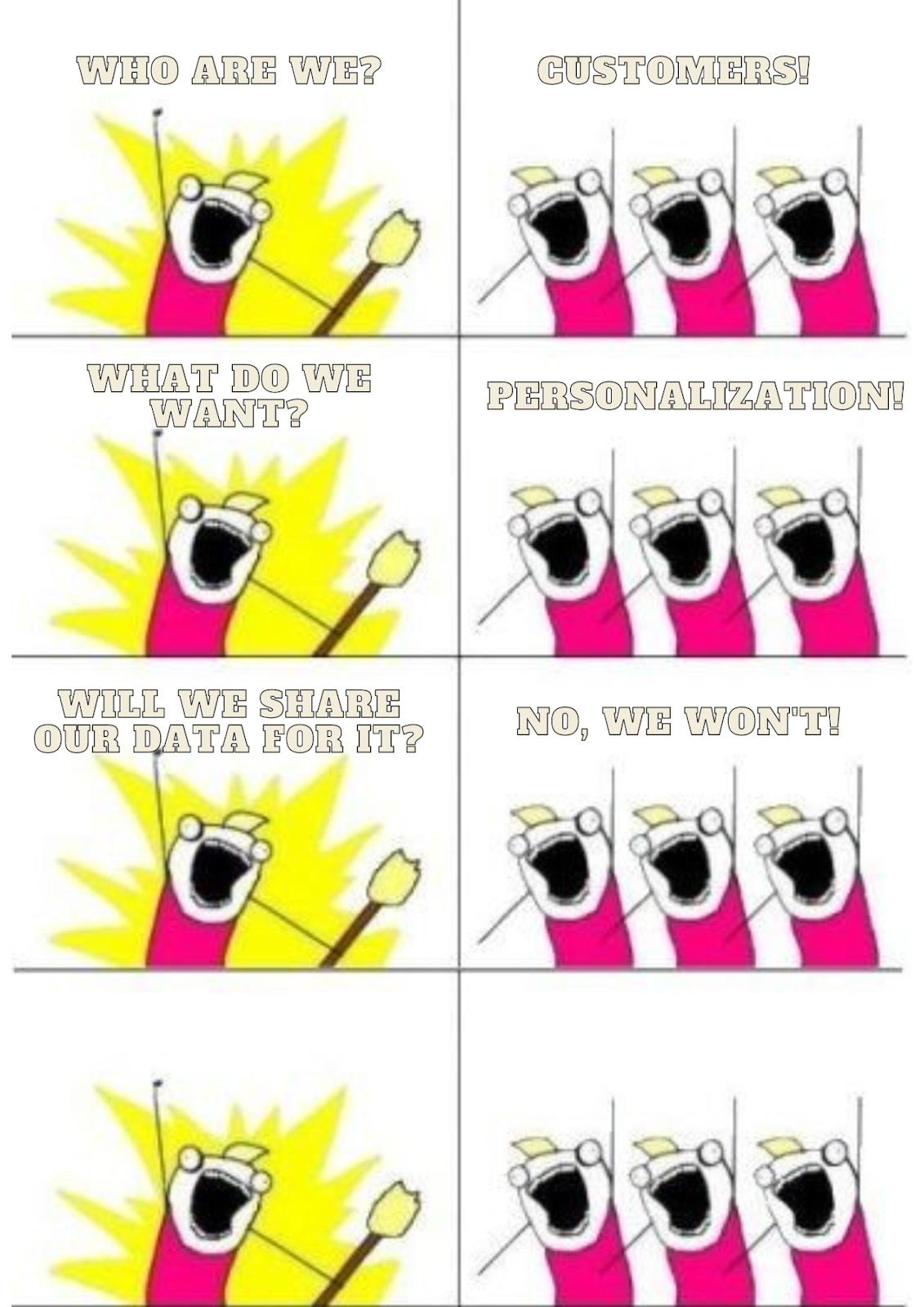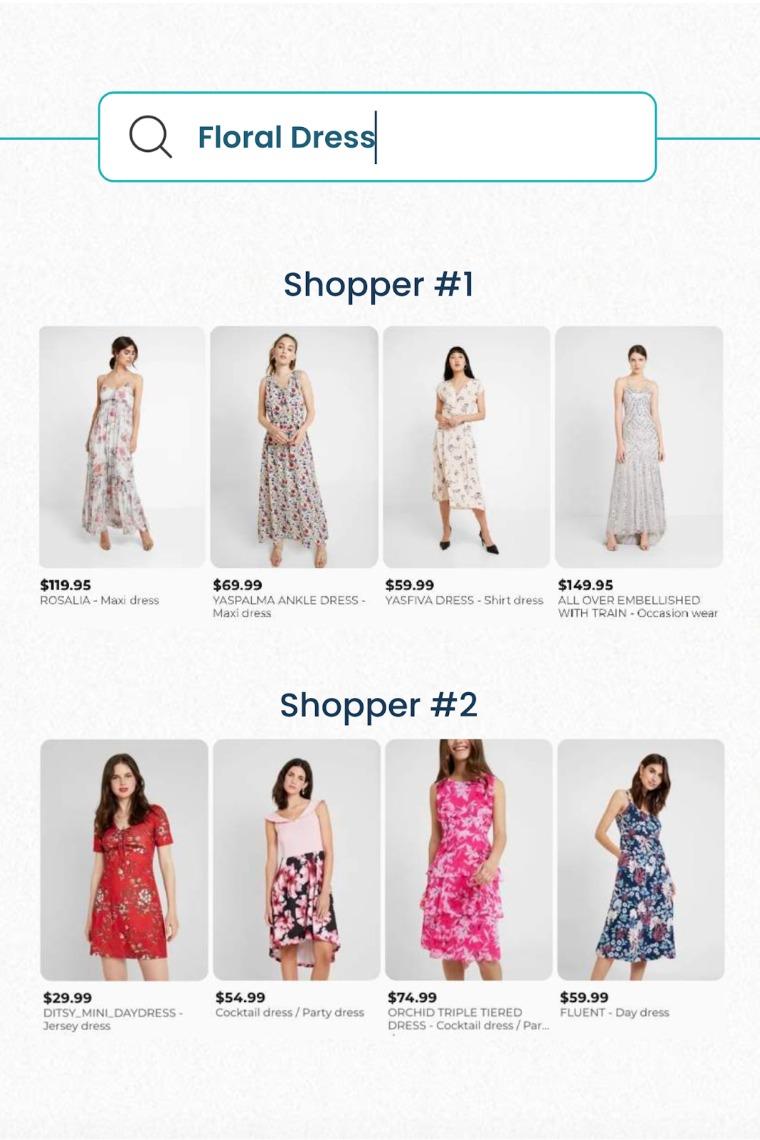What this word should truly mean is putting exactly what your customers need, precisely when they need it, right in front of them!
Because – if it doesn’t take into account your shoppers’ current personal preferences and personal style, why are you calling it personalization?!
Who’s really benefiting from your “personalization”?
Retail marketers have exhausted their promotional arsenals multiple times over the years. The massive expansion of ecommerce and an ever-growing demand for online products, inspired retailers to always push for more.
More traffic, more products, more promotions, more profit!
It made them forget a very important part of this process. Probably the most important part.
The Customer!
Customer satisfaction and retention was never the goal for them. Only a symbolic number representing a line they were afraid of crossing.
Nothing was off the table. It started with – “Leave your email address and get 15% off”. Then it was the demographics – “Dresses for women,” “Handy tools for retired men,” “We deliver locally in London,” etc.
Then social media started dominating. Third party data providers were using every trick in the book to get hold of customer data, so they could sell it to retailers.
Now, one could argue that these practices actually improved online retail performances. Retailers could target and re-target customers with ads more easily. They could put more precise promotions in front of audiences that are more likely to buy. They were even tailoring their offers to specific demographics, making their marketing efforts seem more scalable.
But the key ingredient was still missing – The Customer. Shoppers were never in the focus; it was just their personal information. Guessing that’s where the term personalization comes from. Because these practices are anything but!

The reality is – it all boils down to simple segmentation. Bucketing people into chunks of data based on similar patterns and spamming them with messages and promotions that may never resonate.
Some even go as far as to try segmenting customers based on their previous behavior and using predefined rules for creating offers for each one of those segments.
So buying a pair of sneakers must mean I would want to buy another pair 2 months later?!
Hardly! Preferences change depending on different trends or occasions. The shoes I bought could have been a gift, or a one-time occasion, or a whim. The bottom line is – it doesn’t provide a reliable piece of information you can make informed decisions with.
Here’s what does:
How do consumers see personalization?
Based on the State of Personalization 2023 report, more than half (56%) of customers report they are more inclined to become repeat shoppers following a personalized experience with a retailer.
Both everyday customers and B2B buyers seek tailored shopping experiences. Personalization is the key driver behind their brand loyalty.
According to Sproutsocial, personalization activities can include product recommendations, tailored offers, discounts extending across multiple channels (website, mobile, and social), and various payment options customizable to the shopper’s preference.
Even BCG’s Personalization Maturity Index reveals that retailers employing sophisticated personalization methods generate, on average, four times the revenue of their counterparts with less advanced functionalities.
Furthermore, according to the same research by BCG, “[…]most retailers are nowhere close to delivering the personalized experiences that their customers expect. The vast majority have not even taken the essential first step of defining what personalization means to their customers and businesses.”
So the question still remains – why are retailers still relying on outdated methods for personalization like segmentation, demographic targeting, and collecting personal information?!
With 1 in every 4 users abandoning their shopping cart (IWconnect) when asked to create an account, it’s more than clear that these so-called personalization tactics that require shoppers to provide their personal information are driving them away.
Consumers no longer feel safe sharing their personal data, as they are starting to recognize its value. Privacy concerns are at an all-time high, and as of this year, there will be massive changes in data privacy regulations.
For example, Google announced the replacement of third-party cookies with Privacy Sandbox, which reduces cross-site and cross-app tracking and allows users to browse without their personal information being collected. (TechCrunch, 2023).
Then, there’s Apple and its ATT (Apple Tracking Transparency) framework. This is a mandatory authorization request for app developers to request users’ permission to track activity across other apps and websites. (Forbes, 2023)
Not even top advertisers like Meta will be spared. The company reported losing a whopping $10 billion in revenue due to the ATT introduction. (Business Insider, 2023)
Furthermore, the European Union is looking to enforce the GDPR law across all European countries in 2023. (Forbes, 2023)This shift raises some serious concerns about online advertising and personalization strategies. Relying solely on PII data is no longer a sustainable or ethical approach to personalization.
Solving the paradox: detaching “personalization” from demographics and user profiles
The paradox comes from the fact that customers who are now so privacy-conscious STILL expect the most personalized experience.

The solution is to detach the word personalization from traditional ” personalizing ” methods by collecting data and showing promotions based on segments.
Segmentation fails in so many areas:
1. Lack of Individualization: It puts customers into broad groups and doesn’t account for the individual preferences and behaviors of each customer
2. Oversimplification: Consumers are multidimensional. Their preferences change and vary based on the context and time.
3. Missed opportunities: By focusing on existing segments, businesses often overlook emerging trends in customer demand
4. Privacy: Segmentation relies on collecting a large amount of personal and behavioral data, which might not sit well with all customers.
What if you never asked for their information but could still show a customized product range for each shopper? Like this:

You would be able to offer different options to different customers based on the same query.
What if you were to take things one step further and remove the text search altogether? Simply make sure your prospects see those 12 to 20 items they are most likely to be interested in.
No need to tap into previous purchases, obtain product preferences, or use popups saying, “Those that bought this also liked this.”
None of that.
Only a product feed filled with highly relevant products.

Shoppers can smell the lack of authenticity a mile away.
Just as they’ve seen through retailers’ marketing schemes in past years, they’ve equally started to see through these fake personalization attempts.
Throwing ads at them with the same pair of sneakers they bought two months ago just doesn’t cut it anymore.
Your shoppers deserve true personalization! Schedule a demo to learn more.




